Abstract
As there is uncertainty about the nature of the metabolic defect in vitamin B6-responsive convulsion, certain aspects of pyridoxol metabolism were studied in 3 patients who were believed on clinical grounds to have the condition. The findings were compared with those in healthy children and adults, and in children with mental handicap. The magnitude of the initial rise and the subsequent fall in plasma pyridoxal phosphate (PALP) concentrations after a load of pyridoxol suggested that the vitamin B6-responsive patients were able to synthesise PALP normally but were unable to maintain the prolonged high levels normally found in plasma. The urinary excretion of 4-pyridoxic acid was within normal limits, but the excretion of pyridoxol after the load was raised. It is suggested that there may be an instability of the PALP-albumin complex in this condition. Some of the biochemical features were also observed in an infant presenting with convulsions soon after birth but without evidence of clinical B6-dependency.
Full text
PDF
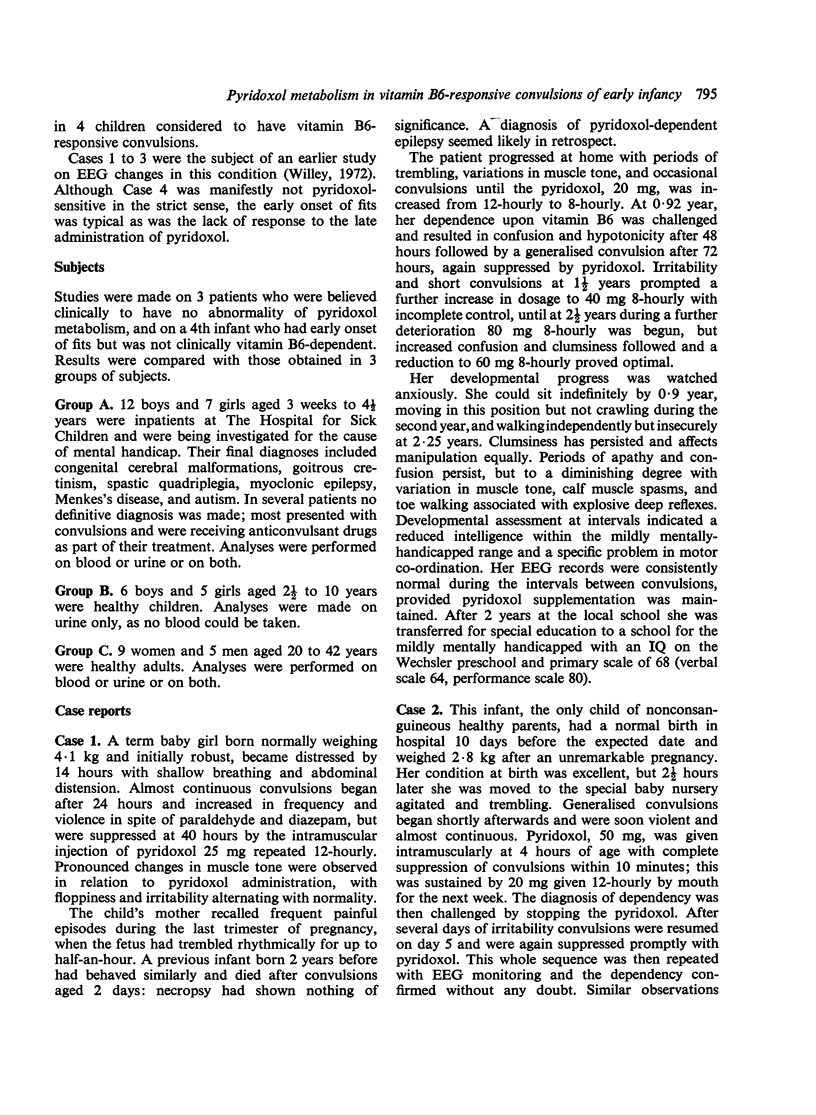
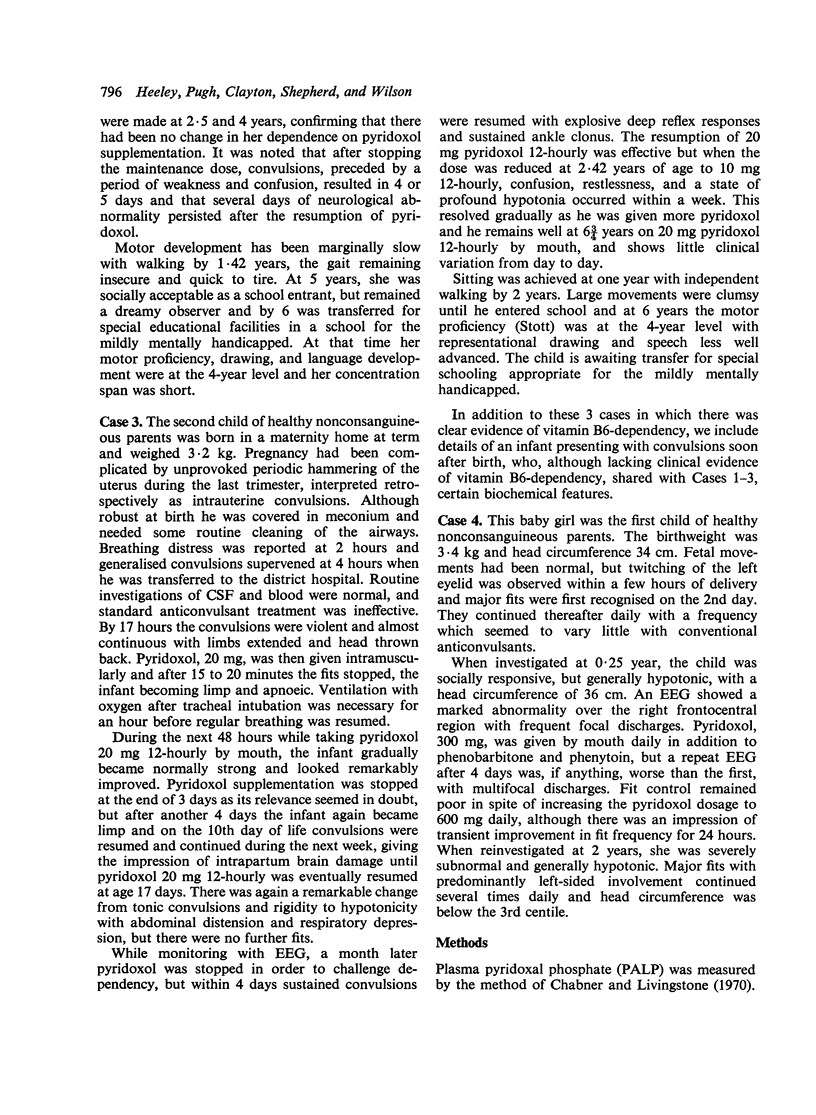
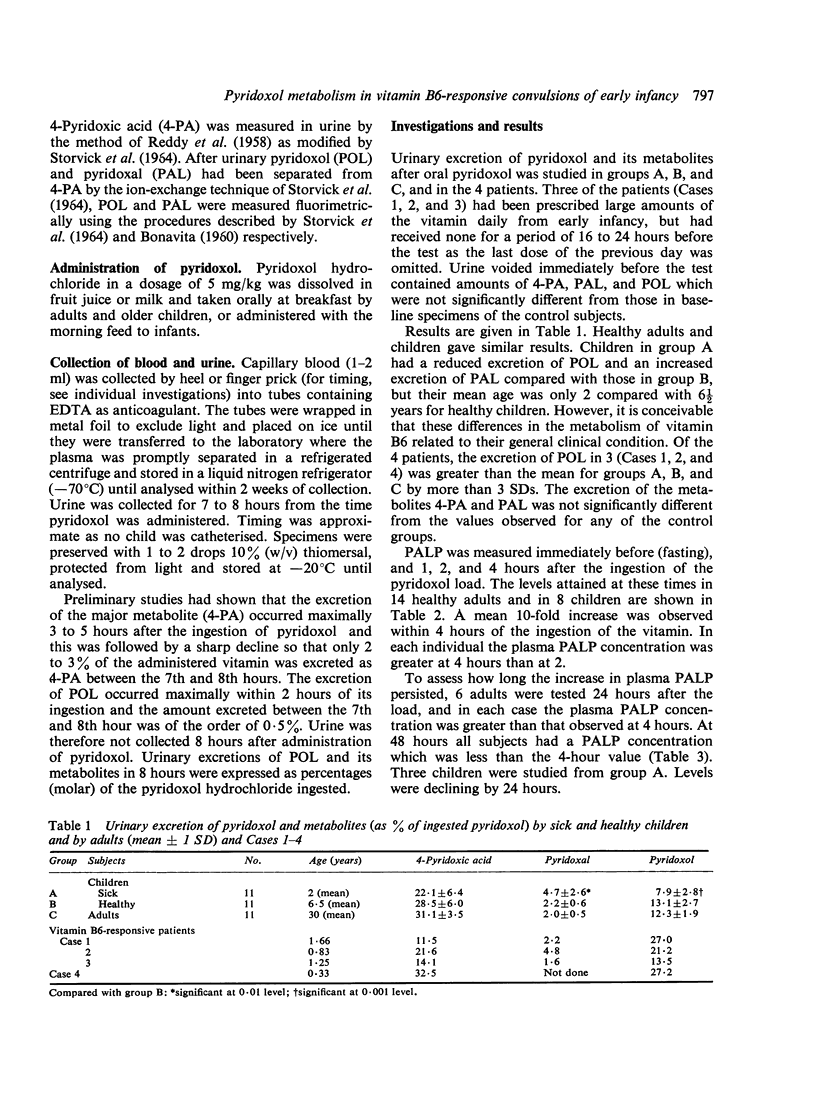


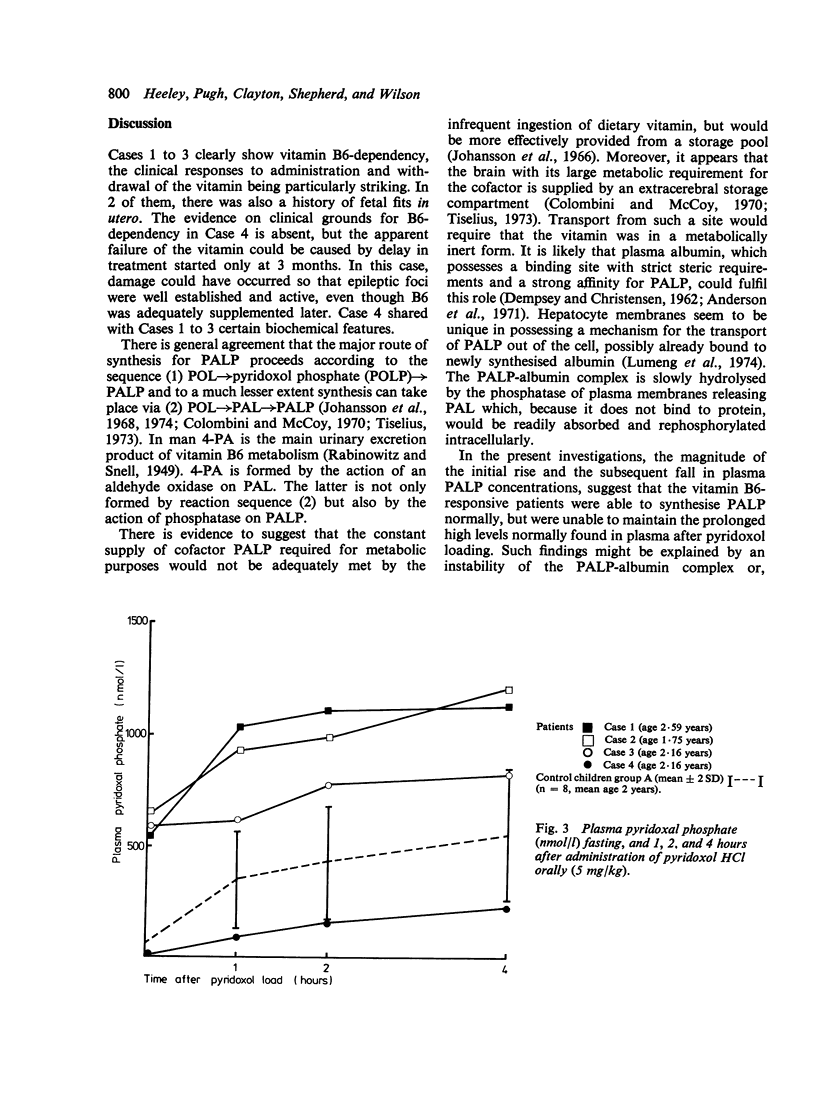
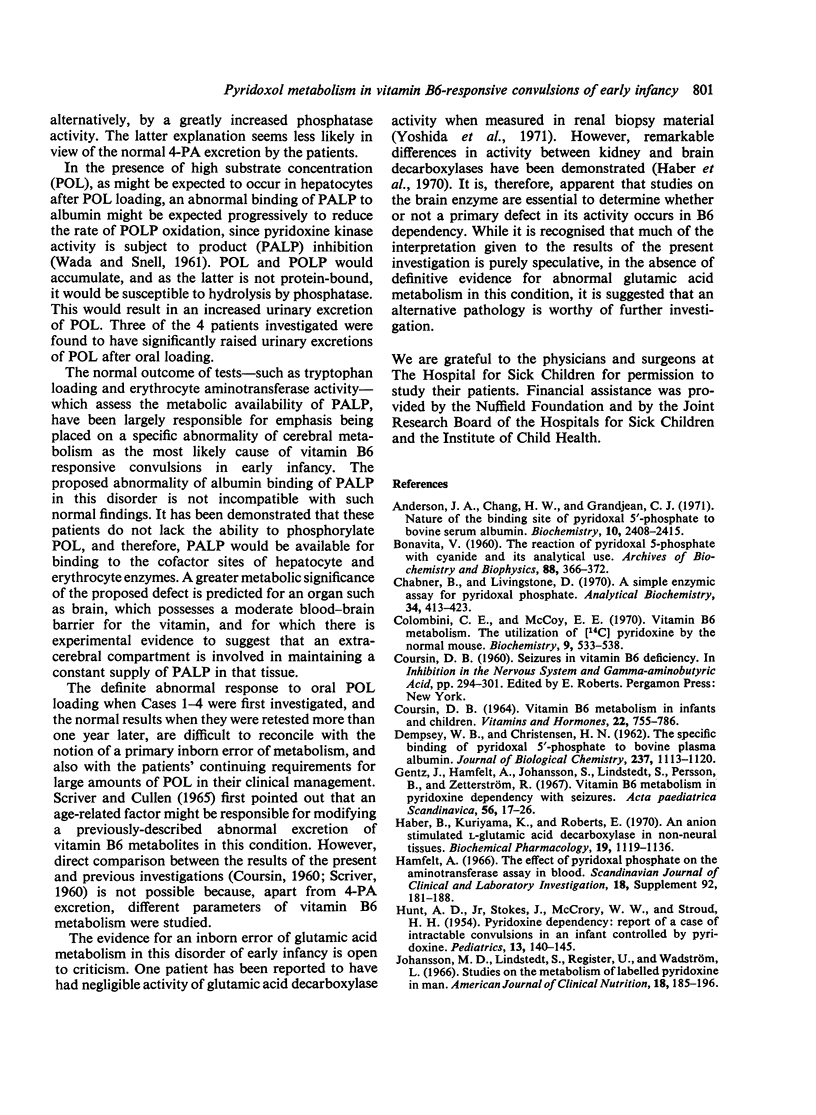
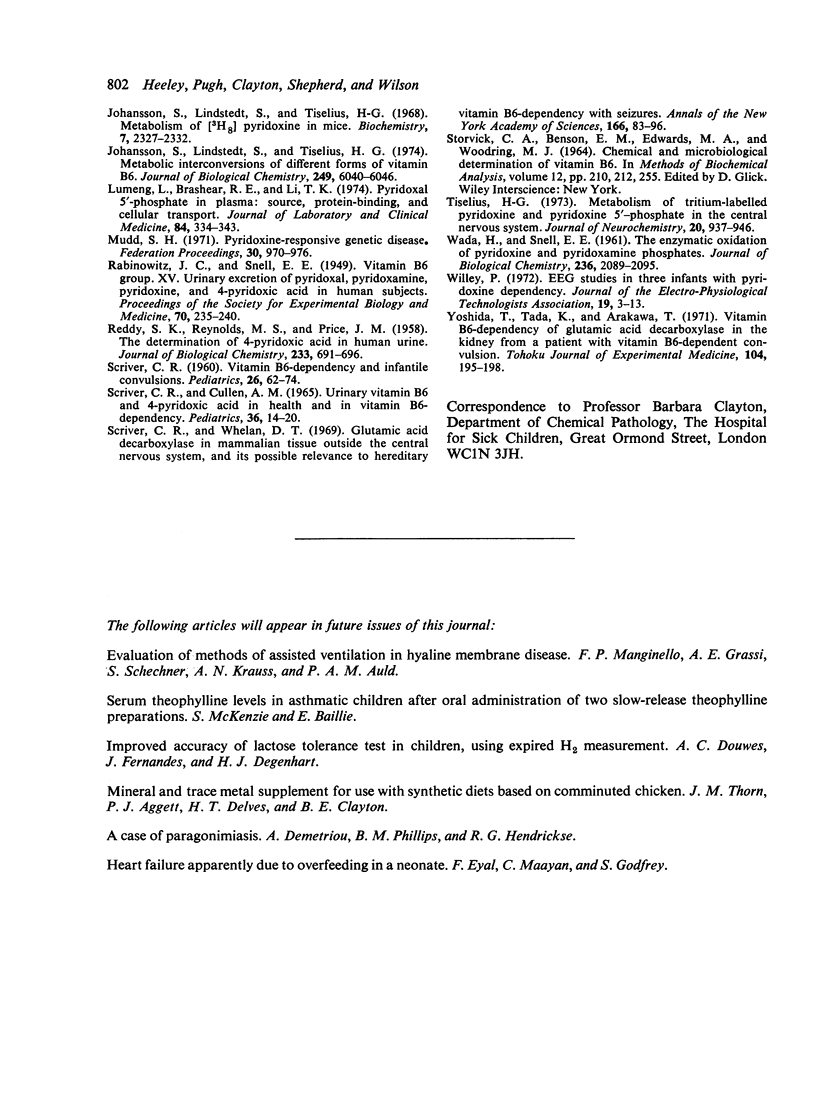
Selected References
These references are in PubMed. This may not be the complete list of references from this article.
- Anderson J. A., Chang H. W., Grandjean C. J. Nature of the binding site of pyridoxal 5'-phosphate to bovine serum albumin. Biochemistry. 1971 Jun 8;10(12):2408–2415. doi: 10.1021/bi00788a035. [DOI] [PubMed] [Google Scholar]
- BONAVITA V. The reaction of pyridoxal 5-phosphate with cyanide and its analytical use. Arch Biochem Biophys. 1960 Jun;88:366–372. doi: 10.1016/0003-9861(60)90252-6. [DOI] [PubMed] [Google Scholar]
- COURSIN D. B. VITAMIN B6 METABOLISM IN INFANTS AND CHILDREN. Vitam Horm. 1964;22:755–786. doi: 10.1016/s0083-6729(08)60363-5. [DOI] [PubMed] [Google Scholar]
- Chabner B., Livingston D. A simple enzymic assay for pyridoxal phosphate. Anal Biochem. 1970 Apr;34(2):413–423. doi: 10.1016/0003-2697(70)90126-0. [DOI] [PubMed] [Google Scholar]
- Colombini C. E., McCoy E. E. Vitamin B6 metabolism. The utilization of [14C]pyridoxine by the normal mouse. Biochemistry. 1970 Feb 3;9(3):533–538. doi: 10.1021/bi00805a012. [DOI] [PubMed] [Google Scholar]
- DEMPSEY W. B., CHRISTENSEN H. N. The specific binding of pyridoxal 5'-phosphate to bovine plasma albumin. J Biol Chem. 1962 Apr;237:1113–1120. [PubMed] [Google Scholar]
- HUNT A. D., Jr, STOKES J., Jr, McCRORY W. W., STROUD H. H. Pyridoxine dependency: report of a case of intractable convulsions in an infant controlled by pyridoxine. Pediatrics. 1954 Feb;13(2):140–145. [PubMed] [Google Scholar]
- Hamfelt A. The effect of pyridoxal phosphate on the aminotransferase assay in blood. Scand J Clin Lab Invest Suppl. 1966;18(Suppl):181–188. [PubMed] [Google Scholar]
- Johansson S., Lindstedt S., Register U., Wadström L. Studies on the metabolism of labeled pyridoxine in man. Am J Clin Nutr. 1966 Mar;18(3):185–196. doi: 10.1093/ajcn/18.3.185. [DOI] [PubMed] [Google Scholar]
- Johansson S., Lindstedt S., Tiselius H. G. Metabolic interconversions of different forms of vitamin B6. J Biol Chem. 1974 Oct 10;249(19):6040–6046. [PubMed] [Google Scholar]
- Johansson S., Lindstedt S., Tiselius H. G. Metabolism of [3H8] pyridoxine in mice. Biochemistry. 1968 Jun;7(6):2327–2332. doi: 10.1021/bi00846a039. [DOI] [PubMed] [Google Scholar]
- Lumeng L., Brashear R. E., Li T. K. Pyridoxal 5'-phosphate in plasma: source, protein-binding, and cellular transport. J Lab Clin Med. 1974 Sep;84(3):334–343. [PubMed] [Google Scholar]
- Mudd S. H. Pyridoxine-responsive genetic disease. Fed Proc. 1971 May-Jun;30(3):970–976. [PubMed] [Google Scholar]
- REDDY S. K., REYNOLDS M. S., PRICE J. M. The determination of 4-pyridoxic acid in human urine. J Biol Chem. 1958 Sep;233(3):691–696. [PubMed] [Google Scholar]
- SCRIVER C. R., CULLEN A. M. URINARY VITAMIN B6 AND 4-PYRIDOXIC ACID IN HEALTH AND IN VITAMIN B6 DEPENDENCY. Pediatrics. 1965 Jul;36:14–20. [PubMed] [Google Scholar]
- SCRIVER C. R. Vitamin B6-dependency and infantile convulsions. Pediatrics. 1960 Jul;26:62–74. [PubMed] [Google Scholar]
- Scriver C. R., Whelan D. T. Glutamic acid decarboxylase (GAD) in mammalian tissue outside the central nervous system, and its possible relevance to hereditary vitamin B6 dependency with seizures. Ann N Y Acad Sci. 1969 Sep 30;166(1):83–96. doi: 10.1111/j.1749-6632.1969.tb54259.x. [DOI] [PubMed] [Google Scholar]
- Tiselius H. G. Metabolism of tritium-labelled pyridoxine and pyridoxine 5'-phosphate in the central nervous system. J Neurochem. 1973 Apr;20(4):937–946. doi: 10.1111/j.1471-4159.1973.tb00064.x. [DOI] [PubMed] [Google Scholar]
- WADA H., SNELL E. E. The enzymatic oxidation of pyridoxine and pyridoxamine phosphates. J Biol Chem. 1961 Jul;236:2089–2095. [PubMed] [Google Scholar]
- Yoshida T., Tada K., Arakawa T. Vitamin B 6 -dependency of glutamic acid decarboxylase in the kidney from a patient with vitamin B 6 dependent convulsion. Tohoku J Exp Med. 1971 Jun;104(2):195–198. doi: 10.1620/tjem.104.195. [DOI] [PubMed] [Google Scholar]


